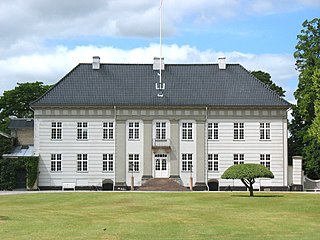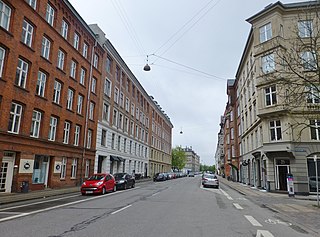
Fuglsang is a 19th-century manor house now operated by Det Classenske Fideicommis as a cultural centre as an active agricultural estate at Toreby on the island of Lolland, in southeastern Denmark. The estate was owned by members of the de Neergaard family from 1819 to 1947. The main building serves as a venue for classical concerts and other cultural activities. The cultural centre also includes Fuglsang Art Museum, located in a purpose-built building designed by British architect Tony Fretton.

St. Luke's Church is a Church of Denmark church located in the Frederiksberg district of Copenhagen, Denmark. Completed in 1897 to the design of Valdemar Koch, who also built several other churches in Copenhagen around that time, it is the second oldest church in Frederiksberg.

Elijah's Church is a Church of Denmark parish church located on Vesterbros Torv in the heart of the Vesterbro district of Copenhagen, Denmark. Completed in 1908 and designed by Martin Nyrop, who has designed Copenhagen City Hall, it was the largest church to be built by the Copenhagen Church Foundation.

Corselitze, or Korselitse, is a manor house on the island of Falster in the south-east of Denmark. The Neoclassical house was built in 1777 by Johan Frederik Classen, who at the time of his death founded Det Classenske Fideicommis, which owns the estate today.

Arresødal is a manor estate situated in Frederiksværk, in Halsnæs Municipality on the island of Zealand in Region Hovedstaden, northeastern Denmark. Surrounded by forest to the west of lake Arresø, it now functions as a private hospice.

The 1853 Copenhagen cholera outbreak was a severe outbreak of cholera which occurred in Copenhagen, Denmark in 1853 as part of the third cholera pandemic. It killed about 4,800 people.

Hesnæs is a little fishing village located 12 kilometres (7.5 mi) southeast of Stubbekøbing on the Danish island of Falster. Its distance from Copenhagen is 125.4 km. It is best known for its thatched, straw-clad houses, not found elsewhere in Denmark.

Corselitze Forest is located on the Danish island of Falster. Situated in the northeast of the island, it contains white pine plantations, although beech is the most common tree species.

Johan Frederik Classen, frequently also J. F. Classen, was a Danish-Norwegian industrialist, major general, landowner and founder of Det Classenske Fideicommis. He served as chancellery adviser to King Frederik V. Classen built the manor house Arresødal in 1773, he renovated the Neoclassical manor house Corselitze in 1777, and built the General's Summerhouse by the Corselitze Forest.

The Classen Library was a public library in Copenhagen, Denmark, created from the private book collection of Johan Frederik Classen at the time of his death in 1792. It was the third largest library in the city, surpassed only by the Royal Danish Library and Copenhagen University Library and existed until 1867 when it was merged with the latter.
Det Classenske Fideicommis is a Danish charitable foundation. By testament in 1789 and his codicil of March 23, 1792, the industrialist Major General Johan Frederik Classen left behind his wealth and possessions as a fund, among other things, to "alleviate poverty and misery". It grants about 2 million kroner ($340,000) annually.

Peter Hersleb Classen, frequently also P. H. Classen, was a Norwegian-Danish statesman and director of Det Classenske Fideicommis.

Frederik Vilhelm Tvede was a Danish architect.

Godthåbsvej is a street in the northwestern part of Copenhagen, Denmark. It begins at Bülowsvej in Frederiksberg as the direct continuation of Rosenørns Allé/Rolighedsvej and passes through Vanløse before reaching Bellahøj in Brønshøj. A metro station on the Copenhagen Metro City Circle Line is located at Aksel Møllers Have.

Nyelandsvej is a street in the Frederiksberg district of Copenhagen, Denmark. It runs from Falkoner Allé in the southeast to a roundabout at the north end of Dalgas Boulevard in the northwest. The more urban, eastern part of the street, between Falkoner Allé and Nordre Fasanvej, separates an area with Copenhagen Business School's Solbjerg Campus and Frederiksberg Centret to the south from the Svømmehal Quarter to the north. The western part of the street is passes the multi-purpose venue Keddelhallen and Frederiksberg Hospital before entering an area with Single-family detached homes.

The Jan von Osten House is a listed Baroque style property at the corner of Amaliegade and Toldbodgade in the Frederiksstaden neighbourhood of central Copenhagen, Denmark. The building was the city home of Johan Frederik Classen from 1770. On his death. it was endowed to the Det Classenske Fideicommis which was headquartered in the building until 1970. The building was listed on the Danish registry of protected buildings and places in 1918.

The English Terrace at Toldbodgade 71– 87 is a row of consecutive terraced houses in the Frederiksstaden neighbourhood of central Copenhagen, Denmark. The terrace was built in 1873–74 to design by Vilhelm Tvede for Det Classenske Fideicommis. It is listed.

Aksel Møllers Have is a public greenspace and early Modernist housing estate located at Godthåbsvej 35–41 in the Frederiksberg district of Copenhagen, Denmark. One of the stations on Copenhagen Metro's City Circle Line is located on the square.

Classensgade is a street in the Østerbro district of Copenhagen, Denmark. It runs from Østerbrogade in the southwest to Østbanegade in the northeast.

Grønnessegaard is a manor house and estate located just east of Hundested in Halsnæs Municipality, Denmark, some 50 kilometres (31 mi) northwest of Copenhagen. The estate was established by Johan Frederik Classen in 1776. The two-storey main building is from 1859.























